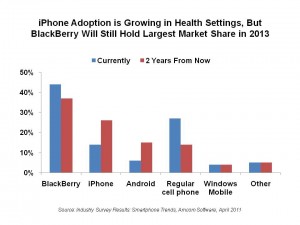 Nearly 1 in two mobile phone platforms in hospitals had a BlackBerry brand in the fourth quarter of 2010. However, within 2 years, more mobile phones will be labeled iPhone or Android, eroding the Blackberry share of the market as health workers abandon their cell phones for smartphones and switch away from their BlackBerry devices. Still, 1 in 3 hospital workers will be using a BlackBerry in 2013, as the chart illustrates.
Nearly 1 in two mobile phone platforms in hospitals had a BlackBerry brand in the fourth quarter of 2010. However, within 2 years, more mobile phones will be labeled iPhone or Android, eroding the Blackberry share of the market as health workers abandon their cell phones for smartphones and switch away from their BlackBerry devices. Still, 1 in 3 hospital workers will be using a BlackBerry in 2013, as the chart illustrates.
Amcom Software conducted a survey of 300 hospitals and health systems in October 2010 to assess their views on smartphones and the emergence of tablets in hospital settings. While paging (job-related alerts) remains a primary messaging category, there’s a wide array of devices used to accomplish it: currently, 55% of pages go to workers’ smartphones; but hospitals also use pagers, traditional cell phones, desk phones, Wi-Fi phones, Vocera badges, email systems, tablets, and other platforms for messaging.
Paying for smartphones varies between institutions: some facilities have policies where physicians agree that smartphones are required and institutions subsidize the standardized platform. In other settings, a diversity of smartphones exists along with the “support headache” that the IT department manages. In a third scenario, institutions subsidize a portion of physicians’ personal smartphone bill that is attributable to the hospital’s business.
While tablets today have the least use when it comes to critical messaging/paging, they are expected to be the most prevalently used paging platform by 2013, with pagers fading into the sunset.
 Health Populi’s Hot Points: When I began working with health providers in the 1980s, the first ‘networking’ device I bumped into in hospitals was the fax machine. Then, those machines were multiplying like rabbits, connecting labs with doctors and nurses’ stations within hospitals, and between doctors’ offices and ancillary departments for communicating test results. Then PCs proliferated desktops, further adding to the communications platform mix. Today, the average physician in a hospital can have several devices hanging from his belt. The diversity of device types multiples, and the brands within each device type, as well. The permutations are endless — and the devices have typically been additive, not substituting.
Health Populi’s Hot Points: When I began working with health providers in the 1980s, the first ‘networking’ device I bumped into in hospitals was the fax machine. Then, those machines were multiplying like rabbits, connecting labs with doctors and nurses’ stations within hospitals, and between doctors’ offices and ancillary departments for communicating test results. Then PCs proliferated desktops, further adding to the communications platform mix. Today, the average physician in a hospital can have several devices hanging from his belt. The diversity of device types multiples, and the brands within each device type, as well. The permutations are endless — and the devices have typically been additive, not substituting.
With the advent of the tablet, like the iPad, there’s an opportunity to significantly slim down the volume of devices a clinician, doctor or nurse, needs to lug around. Amcom points out that, “there is good progress toward an interconnected enterprise of devices to endpoints,” and this is a good thing that ensures continuity of care and information liquidity that can get to an electronic health record and into clinician’s hands at the point-of-care for better clinical decision making. The first device to disappear from the constellation of communications platforms will be the pager. After that, the cell phone will morph into smartphone adoption for all health workers.
The tablet’s adoption in health will be swift, based on this and many other health user surveys looking into the near-term of mobile health technology adoption among clinicians.




 I am so grateful to Tom Lawry for asking me to pen the foreword for his book, Health Care Nation,
I am so grateful to Tom Lawry for asking me to pen the foreword for his book, Health Care Nation,  Thanks to Feedspot for naming this blog, Health Populi, as a
Thanks to Feedspot for naming this blog, Health Populi, as a